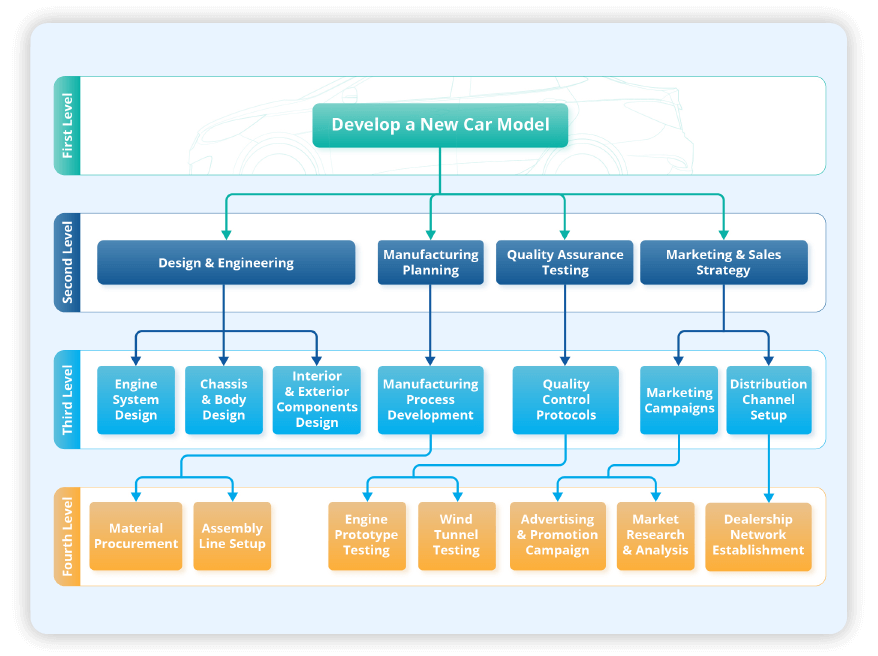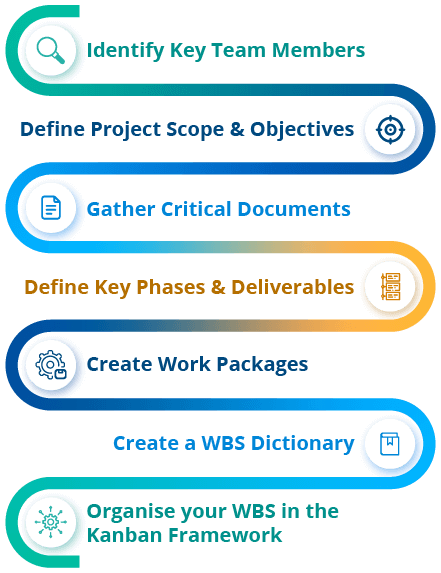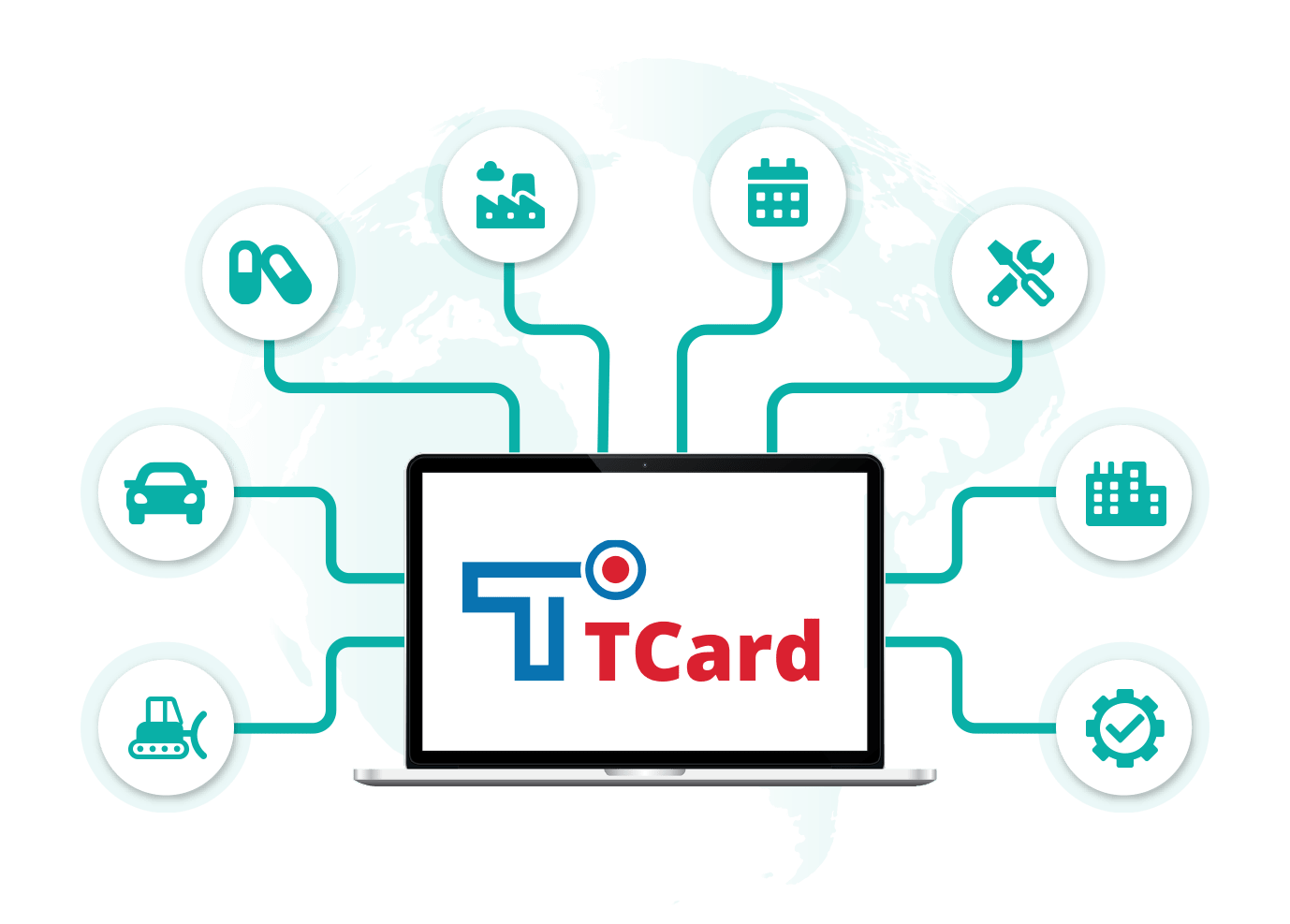Contents
-
Work Breakdown Structure for Project Management
- 1.1What is a Work Breakdown Structure (WBS)?
- 1.2 Why is WBS important?
- 1.3What are the characteristics of a WBS?
- 1.4How would Work Breakdown Structure help you as a Project Manager?
- 1.5Work Breakdown Structure Example
- 1.6Work Breakdown Structure Template
- 1.7Who benefits from WBS?
- 1.8 Is a Work Breakdown Structure a project plan?
-
Kanban Work Breakdown Structure for Seamless Project Management
- 2.1Work Breakdown Structure in Project Management with Kanban Boards
- 2.2Benefits of implementing the visual WBS approach with Kanban
- 2.3Creating a Work Breakdown Structure within a Kanban framework
- 2.4Best practices for creating a Work Breakdown Structure for Kanban projects
- 2.5Does every task on a Kanban board need to be part of the Work Breakdown Structure?
- 2.6Can a Work Breakdown Structure in Kanban be adapted for different types of projects?
- 2.7Common mistakes to avoid when implementing Kanban boards in Work Breakdown Structure
- 2.8 Difference between Work Breakdown Structure and a Work Breakdown Schedule
- 2.9In what ways does Kanban provide a dynamic approach to the traditional Work Breakdown Structure ?
Work Breakdown Structure for Project Management
What is a Work Breakdown Structure (WBS)?
A Work Breakdown Structure, commonly known as WBS, is a useful tool in project management, which helps to split a project into smaller, more manageable components. The WBS defines the project's ultimate goal, providing a high-level view of what the project aims to achieve. In Lean Six Sigma, the Work Breakdown Structure (WBS) serves as a pivotal tool for organising and structuring project tasks within the DMAIC (Define, Measure, Analyse, Improve, Control) methodology.
The three main types of WBS include:
-
Phase-based WBS:
The Phase-based WBS positions the final deliverable at the top, with subsequent levels outlining the project's five phases (initiation, planning, execution, control, and closeout). Like deliverable-based WBS, it breaks down project phases into deliverables and work packages, ensuring a structured approach. -
Process-oriented WBS:
The Process-oriented WBS dissects work into essential processes like requirements, design, development, and testing. This breakdown method clarifies tasks and designates specific task owners, streamlining project execution. -
Deliverable-oriented WBS:
A Deliverable-oriented WBS presents a hierarchical tree structure of the project, breaking down work into tangible products or services like database schemas and user manuals. It effectively showcases the link between high-level deliverables and the corresponding tasks, promoting seamless project understanding.
The primary purpose of WBS is to provide a clear and organised breakdown of the project scope, tasks, and deliverables, allowing for a detailed understanding of its objectives. By breaking down the project into these smaller elements, teams can grasp the project’s complexity, allocate resources effectively, and establish a structured approach to project execution. The key components or elements of a Work Breakdown Structure are WBS dictionary, WBS levels, Project deliverables,Work packages, Planning packages, Control accounts and tasks.
At the top level, WBS provides a systematic and structured approach to project planning and execution of a project. Moving to the second level, it outlines the project outcomes, breaking down the ultimate goal into specific results contributing to the project’s success. The third level delves into project outputs, detailing the tangible deliverables and milestones that mark progress toward achieving outcomes. Finally, the fourth level or Work Packages shows activities, representing the specific tasks and subtasks necessary to produce the outputs.
The WBS 100 rule is a project management principle that ensures the Work Breakdown Structure (WBS) covers 100% of the project scope. According to this rule, the WBS should encompass all the work required to complete the project successfully, leaving no tasks or components unaccounted for.
Why is WBS important?
A Work Breakdown Structure (WBS) in project management holds immense importance as it can bring structure and clarity to complex projects. It acts as a roadmap, breaking down the entire project into manageable tasks, sub-tasks, milestones, and deliverables. This systematic approach helps to:
- Enhance project understanding
- Allocate resources efficiently
- Estimate costs accurately
- Establish realistic timelines
- Aids in task prioritisation
- Facilitates effective communication
- Helps identify dependencies and potential risks
Furthermore, it serves as a foundation for project scheduling, enabling project managers to monitor progress, track achievements, and ensure that the project stays on course. Ultimately, the WBS is essential for ensuring project success, enhancing collaboration, and optimising project management processes.
What are the characteristics of a WBS?
The key characteristics of a Work Breakdown Structure (WBS) includes:
-
Hierarchical Structure:
WBS organises tasks by breaking down complex projects into smaller, manageable components. -
Task Decomposition:
It categorises major tasks into smaller, detailed sub-tasks, ensuring a granular view of the project scope. -
Clear Outline:
Provides a clear idea for project scope, tasks, milestones, and deliverables, enhancing project understanding. Visual Representation:
Often presented visually, allowing stakeholders to grasp project components at a glance, aiding effective communication.Unique Identifier:
Assigns a unique identifier to each element, facilitating tracking, referencing, and organisation of project components.Scope Definition:
Defines project boundaries, ensuring all necessary work is included while preventing scope creep.Responsibility Assignment:
Transparency and efficient workflow management are ensured by identifying who is accountable for each component of the project.Flexible and Adaptable:
Allows for modifications as the project progresses, accommodating new changes in requirements.Cross-functional Collaboration:
Encourages collaboration among different departments, aligning their efforts with the overall project goals.Time and Cost Estimation:
Enables accurate estimation of time, resources, and costs associated with each task, aiding in project planning and budgeting.
How would Work Breakdown Structure help you as a Project Manager?
Work Breakdown Structure empowers project managers with a structured approach to planning, executing, and controlling projects, leading to more efficient and successful outcomes. As a Project manager, a Work Breakdown Structure (WBS) is an invaluable tool to:
- Organise complex projects into manageable subtasks
- Provide enhanced task clarity
- Facilitate Resource allocation
- Aids in accurate time and cost estimation
- Set a foundation for project scheduling, risk assessment, and progress monitoring.
- Enhance team communication
Work Breakdown Structure Example
Let’s discuss a Work Breakdown Structure for Developing a New Car Model in the Automotive Sector. By breaking down the projects into these hierarchical levels, teams can effectively plan, manage, and execute tasks, ensuring successful project outcomes.

Work Breakdown Structure Template
A Work Breakdown Structure (WBS) template serves as a foundational framework in project planning and management. It typically uses a hierarchical format, breaking down the project into phases, deliverables, and work packages. The WBS template employs a visual structure, often presented as a tree diagram, to represent the tasks and sub-tasks in a clear and organised manner. WBS templates include detailed descriptions of each component, outlining the scope of work, required resources, dependencies, and timelines. Utilising WBS in project planning, enhances task visibility, and aids in effective communication among the team members, ensuring a systematic approach to project execution and successful completion.
Who benefits from WBS?
The Work Breakdown Structure (WBS) benefits various stakeholders involved in a project. Project managers, team members, and stakeholders benefit from the WBS as it provides a clear roadmap, aiding in project planning, execution, and monitoring. Project managers create the WBS, organising tasks and resources, ensuring efficient allocation and alignment with project goals. The Client Facing Groups, members dealing with internal and external projects, Commercial Project Planners, and Planning Managers benefit from WBS by having a structured view of tasks, promoting clarity and accountability. Stakeholders, including clients and sponsors, benefit from transparent communication and understanding of project components, ensuring their expectations align with project outcomes. The WBS is valuable for effective collaboration, streamlined project management, and successful project delivery.
Is a Work Breakdown Structure a project plan?
No, a Work Breakdown Structure (WBS) is not a project plan in itself. Instead, it aids in project planning by breaking down complex projects into manageable sub-tasks and components. The WBS provides a structured framework outlining the hierarchy of project elements and their relationships. It serves as a visual tool to depict the workflow necessary to achieve the project goal. While the WBS is a crucial part of project planning, a comprehensive project plan includes additional elements such as timelines, resources, budgets, and risk assessments. The WBS acts as a foundational step, guiding the development of a detailed project plan, but is not the entirety of the plan itself.
Get a Personalised Demo to understand how WBS can benefit your Project Management
Kanban Work Breakdown Structure for Seamless Project Management
Work Breakdown Structure in Project Management with Kanban Boards
Utilising a Work Breakdown Structure (WBS) with Kanban boards in project management is a strategic approach to enhance project organisation and workflow efficiency. By breaking down the project into smaller, manageable tasks through WBS, teams can comprehensively understand the project scope, identifying essential components and dependencies. This structured breakdown forms the foundation for creating tasks on Kanban boards, ensuring that every aspect of the project is meticulously planned and executed. Kanban boards visually represent the project tasks, allowing team members to track progress, allocate resources, and prioritise events in real time. Utilising WBS with Kanban boards facilitates seamless collaboration, enhances task visibility, and swiftly empowers teams to adapt to changing project requirements. This integration fosters a responsive project management environment, enabling teams to deliver high-quality results within the defined timeframe and budget constraints. Utilise project management software or specialised WBS software tools like Kanban Boards for digital organisation and collaboration.
Benefits of implementing the visual WBS approach with Kanban
-
Enhanced Project Visibility:
Implementing the visual Work Breakdown Structure (WBS) with Kanban provides a clear, visual representation of project components. Team members can easily understand the project scope and goals by viewing the overall structure. -
Improved Task Clarity:
The visual WBS in Kanban enhances task clarity by breaking down complex projects into manageable tasks and sub-tasks. Each task is clearly defined and aligned with specific WBS elements, ensuring team members understand their roles and responsibilities. -
Dynamic Task Tracking:
Kanban's flexibility allows real-time task tracking and adaptation. As tasks move across Kanban columns, reflecting their progress, the visual WBS ensures that every task aligns with the project’s overall structure, providing a dynamic and adaptable approach to project management. -
Efficient Resource Allocation:
Project managers can allocate resources effectively by integrating visual WBS with Kanban boards. The structured breakdown of tasks allows for efficient resource allocation based on the specific requirements of each WBS element, optimising team productivity. -
Streamlined Collaboration:
Visualising the WBS through Kanban promotes collaboration and communication among team members. Everyone can see the project’s structure, enabling seamless collaboration and ensuring everyone is aligned with the project objectives.
Creating a Work Breakdown Structure within a Kanban framework

-
Identify key team members:
Begin by assembling a team comprising individuals with relevant skills and expertise for the project. Having the right team members ensures diverse perspectives and abilities, essential for creating a comprehensive Work Breakdown Structure (WBS) within the Kanban framework. -
Define project scope and objectives:
Understanding what needs to be achieved in the project provides a roadmap for creating the WBS, guiding the team towards the project's successful completion. -
Gather critical documents:
Collect all essential records related to the project, such as project charters, requirements documents, and any existing project plans. It serves as a valuable reference during the WBS creation process, ensuring that all necessary components are included. -
Define key phases and deliverables:
Break down the project into distinct categories and identify the corresponding deliverables for each phase. Phases help organise the project timeline, and deliverables provide tangible goals, making allocating tasks and creating detailed work packages easier. -
Create work packages (tasks and sub-tasks):
Each work package should be Specific, Measurable, Achievable, Relevant, and Time-bound (SMART criteria). This step involves detailed planning and consideration of dependencies between tasks. -
Create a WBS dictionary:
A WBS dictionary includes task descriptions, responsible team members, resource requirements, estimated duration, and other relevant details of work packages. A well-maintained WBS dictionary enhances communication and understanding among team members. Organise your WBS in the Kanban framework:
Utilise Kanban boards to visualise tasks, track progress, and manage workflow efficiently. Assign tasks to team members, set priorities, and establish a continuous feedback loop to ensure tasks move smoothly through the workflow stages, from initiation to completion. Integrating WBS into Kanban enhances transparency and aids in real-time project monitoring and adaptation.
Start creating your Work Breakdown Structure with Kanban Boards
Best practices for creating a Work Breakdown Structure for Kanban projects
- Start with Clear Project Objectives: Understand the project scope, goals, and deliverables to ensure the WBS aligns with the project's purpose.
- Involve Cross-Functional Teams: Include key stakeholders, project managers, and team members to capture a comprehensive range of tasks and dependencies.
- Hierarchical Decomposition: Organise tasks into main phases, deliverables, and sub-tasks. This structured approach ensures a systematic breakdown of work components.
- Use Action-Oriented Language: Tasks should be clearly defined and actionable, facilitating easy assignment and understanding. Use verbs to describe activities and create concise task descriptions.
- Align WBS Elements with Kanban Columns: Each WBS task or subtask should correspond to a Kanban card. Aligning WBS components with Kanban columns visually represents the project's structure and progress. As tasks move across columns, their status is reflected in the workflow.
Does every task on a Kanban board need to be part of the Work Breakdown Structure?
Not necessarily. While tasks on a Kanban board are essential for tracking progress, not every task needs to be part of the Work Breakdown Structure (WBS). Kanban allows flexibility by accommodating various tasks and activities, including minor tasks for continuous improvement efforts. These smaller tasks may not be significant enough to warrant inclusion in the WBS but are crucial for day-to-day operations and workflow management. Therefore, while WBS provides a structured breakdown of major project components, Kanban boards can encompass a broader range of activities, ensuring teams can manage both planned project tasks and spontaneous, smaller activities efficiently.
Kanban boards enhance the visual aspect of WBS by transforming static project structures into dynamic, interactive boards. Each task derived from the WBS can be represented as a card on the Kanban board. These cards can move across different columns representing various stages of the workflow, such as "To Do," "In Progress," and "Done." Team members can easily track the status of tasks, monitor progress, and identify bottlenecks or delays.
Can a Work Breakdown Structure in Kanban be adapted for different types of projects?
Yes, a Work Breakdown Structure (WBS) in Kanban can be adapted for different types of projects. The flexibility of Kanban allows teams to customise their workflows and adapt the WBS based on the unique requirements of each project. Whether it's software development or product launches, the hierarchical structure of WBS can be tailored to fit the specific project scope. By aligning WBS elements with Kanban columns, teams can visualise, manage, and track tasks effectively, seamlessly adapting to diverse project types. This adaptability promotes efficient project planning, execution, and monitoring, making Kanban a versatile methodology for various project scenarios.
Common mistakes to avoid when implementing Kanban boards in Work Breakdown Structure
- Incomplete WBS Integration: Avoid the mistake of not integrating all WBS components into the Kanban board. Incomplete alignment can lead to missed tasks and incomplete project tracking.
- Lack of Task Clarity: Ensure tasks on the Kanban board are clear and specific, directly relating to WBS elements. Unclear tasks can cause confusion, hampering efficient workflow management.
- Ignoring Dependencies: Address task dependencies within the WBS. Failing to consider dependencies when organising tasks on the Kanban board can disrupt the workflow and lead to delays.
- Overcomplicating WBS Structure: Keep the WBS structure simple and focused. Overcomplicating the breakdown can confuse team members and hinder the Kanban board's usability.
- Neglecting Regular Updates: Regularly update the Kanban board to reflect changes in the WBS. Neglecting updates can lead to outdated information, affecting project progress monitoring and decision-making.
Difference between Work Breakdown Structure and a Work Breakdown Schedule
The primary difference between a Work Breakdown Structure and a Work Breakdown Schedule lies in their scope and level of detail. Work Breakdown Structure is a hierarchical breakdown of the project into phases, deliverables, and work packages, providing a structured overview. It focuses on what needs to be done. On the other hand, a Work Breakdown Schedule is a time-bound plan that assigns specific dates, durations, and resources to each work package identified in the Work Breakdown Structure. It outlines when and how the work packages will be executed, translating the WBS into a detailed project timeline. While Work Breakdown Structure focuses on the breakdown of tasks and their relationships, a Work Breakdown Schedule adds the element of time, creating a dynamic roadmap for project implementation.
In what ways does Kanban provide a dynamic approach to the traditional Work Breakdown Structure ?
Kanban offers a dynamic approach to the traditional Work Breakdown Structure (WBS) by introducing real-time adaptability and continuous improvement for project management initiatives. Unlike the static nature of a traditional WBS, Kanban allows teams to adjust priorities, allocate resources, and respond to changing project requirements on the go. Through visual boards, Kanban provides a real-time overview of tasks, enhancing transparency and collaboration among team members. Breaking down projects into smaller tasks for continuous refinement and reprioritisation enables gradual planning and delivery. This agility in project planning and execution ensures that teams can swiftly address emerging challenges, optimise workflows, and improve overall project efficiency. Using Kanban boards in the Work Breakdown Structure ensures a flexible, responsive, and dynamic approach to project management. This fosters adaptability in the face of evolving project needs.


